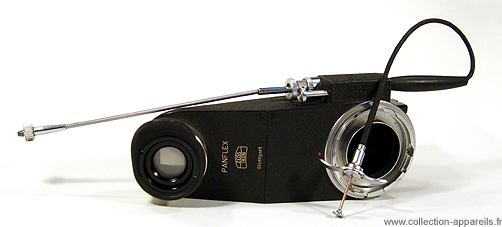|
Zeiss Ikon Contax IIa (563/24) |
Manufactured or assembled in Germany from 1945 to 1956.
Index of rarity in France: Infrequent (among non-specialized garage sales)
Inventory number: 12069
See the complete technical specifications
Chronology of cameras Zeiss Ikon
Zeiss rises from its ashes!
1945: Dresden is destroyed by the bombardments: the plans, the studies, the tools ... and the majority of human resources which had made it possible to produce the Contax II before the war have passed to the other side of the Iron Curtain, and are resuming service under the brand Kiev.
A handful of engineers decides to continue the prestigious Zeiss production in Stuttgart. First challenge: remake a Contax II, but better.
The Contax IIa is quite similar in appearance to its predecessor (see comparison of the two below), but hardly shares any parts with it: Zeiss engineers got back to work almost from scratch.


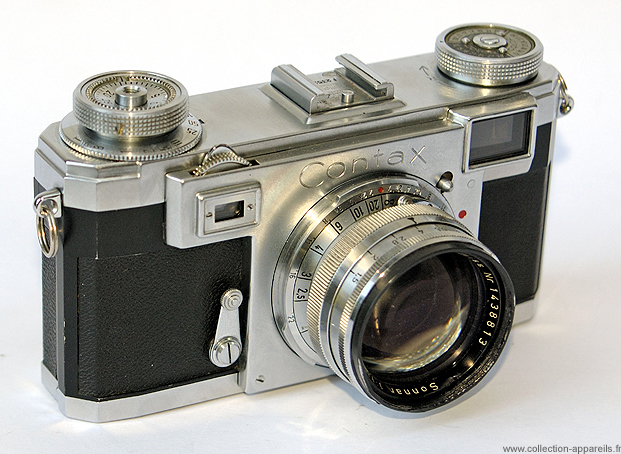
If the Contax IIa uses the pre-war bayonet system and the vertical metal curtain principle, its mechanism is significantly improved and simplified.
Thus the slow speed mechanism is easily accessible by removing the top cover, and its adjustment is infinitely less delicate than for the pre-war versions where it was necessary to venture into the heart of the camera.
The Contax IIa is a camera with interchangeable lenses on a bayonet mount. It features two types of bayonets, one with an internal ramp and one with an external ramp. The rangefinder is coupled. The three 50mm lenses, two Sonnars opening at 1.5 and 2, and the Tessar opening at 3.5, do not have a distance scale; instead, it is integrated into the camera body and engraved from 0.9m to infinity or from 3 feet to infinity for certain export versions of the camera.
The aluminium curtain shutter, with setting ring, features a speed range from 1/1250 of a second up to one second, as well as the B and T long time exposures. It is fitted with a Zeiss specific flash sync socket on the back which requires the use of a special cord for the use of standard flashes. It also features a standard accessory shoe (on the top cover) and a self-timer. There were two types of flash sync cords, one for flash bulbs (synchronization at 1/25 sec.) and one for electronic flashes (synchronization at 1/50 sec.).
The Zeiss Contax IIa was produced from 1950 to 1961.
It uses 35mm perforated cine film loadable in a special Contax cassettes. Modern films in 135 format cartridges can be used.
The 1954 version.
Not to mention the variants such as the inscription in meters or feet on the distance ring, or the second window of the telemetric viewfinder a little smaller and without the two screws (bodies serial number prior to around 25,000), Zeiss Stuttgart will release in 1954 a version that the Anglo-Saxons will call "color dial" as opposed to the earlier version "black dial". In this new version, the setting ring speed markings are coloured, remaining in black from 1 second to 1/25, and becoming orange for 1/50 which is the flash synchronization speed and red from 1/100 to 1/1250. In addition, in this new version, the flash sync socket is standardised, making it unnecessary to use the specific flash sync cords.
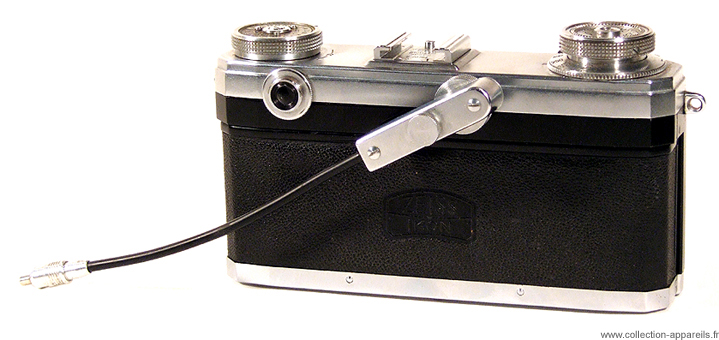
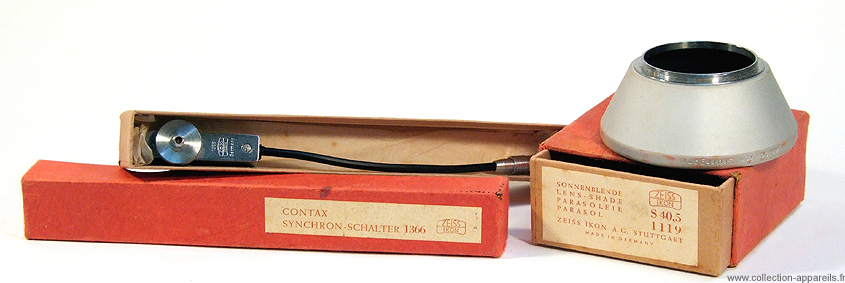
In the picture below, the "color dial" version is on the left.
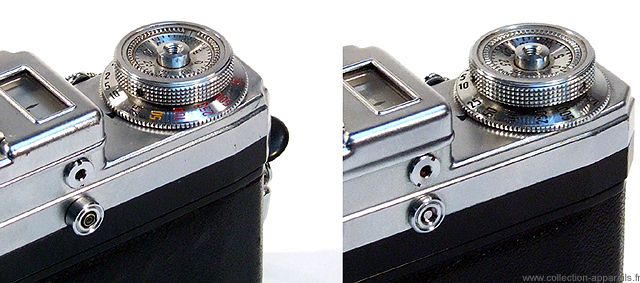
Summary comparison with the pre-war Contax II.
The Contax IIa is slightly smaller and lighter. There is no longer a support under the sole since no more part is prominent there. The rangefinder base is shorter but still respectable with 73mm. The "Contax" marking is curved around the lens and no longer straight. The mechanism is simplified and more judiciously arranged, making maintenance operation easier. The viewfinder is larger. But the most appreciable difference is the cocking. In the pre-war Contax II, incomplete cocking followed by an attempt to change shutter speed led to malfunction and sometimes even breakdowns. In the Contax IIa this inconvenience disappears and the shutter speed setting can be done before or after cocking without any risk.
The Contax IIa lenses
From its release, the Contax IIa had a respectable lens range. But in this area too, the break-up of Germany after World War II has left its mark.
While Carl Zeiss Jena continued to produce optics in Jena (East Germany after the war), an optics factory was established in Oberkochen (West Germany) to meet the needs of Zeiss Ikon AG. Stuttgart.
The lenses supplied by Carl Zeiss Jena have serial numbers in the continuity of the pre-war period, without distinction of lens type, and still with the engraving "Carl Zeiss Jena". That is to say, with serial numbers starting from around 3,000,000 after the war. Oberkochen factory began to number its productions indistinctly from 10,000. But where it gets complicated is that a close collaboration existed at the beginning between the two factories. The optics released from Oberkochen are first engraved with "Opton" and later, as a result of various legal trials, simply "Carl Zeiss". All the post-war optics produced by Iena or Oberkochen benefit from a anti-reflection coating and are engraved with a red capital T for the designation "tranzparenz".
The lenses available as standard in 1951 for the Contax IIa:
| Biogon | 2,8 / 35 mm |
| Sonnar | 1,5 / 50 mm |
| Sonnar | 2 / 50 mm |
| Tessar | 3,5 / 50 mm |
| Sonnar | 2 / 85 mm |
| Sonnar | 4 / 135 mm |
| Sonnar | 2,8 / 180 mm |
| Sonnar | 4 / 300 mm |
And some other special optics like the late Tessar 3.5 / 115 mm for use with the Panflex, the 3.5 / 50 mm macro lens mounted in the focusing head of the “Contaprox” or an also late 8 / 500 mm.
The 180, 300 and 500 mm were productions of the East (Carl Zeiss Jena), marketed by Stuttgart more for cost reasons than know how, and were used with the special mirror viewfinder "Flektoscop".
All the pre-war Contax II lenses fit on the Contax IIa except the Biogon.
Macro-photography in the 1950s, according to Contax
Zeiss Stuttgart manufactured a very complete and very precise set for micro and macro photography. From reproduction stands to bellows and extension tubes to a special lens, the Tessar 1:3.5 50mm which is the first macro lens ever made.
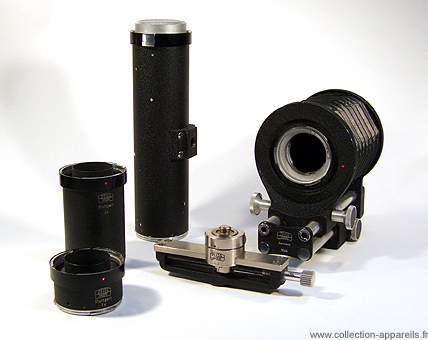
The Tessar macro lens, sold as part of the “Contaprox” set, could be used directly on the Contax IIa but required the use of an impractical parallax-corrected rangefinder focusing device, the “Contameter” which was mounted on the camera accessory shoe. It was better to use this macro Tessar with the ground glass based focusing system of the "Contaprox" or "Panflex", with or without extension tubes.
The German-language book Das Contax Buch describes at length the Contax IIa use for macro photography. This book was published in 1953 by Heeiring Verlag and is written by Otto Croÿ who had already signed a Contax Buch in 1942 but dealing with the pre-war Contax II.
The Contaprox
The Contaprox is a set consisting of a focusing head, an extension tube fitted with a ground glass and a magnifying glass with dioptric correction. The extension tube carrying the ground glass has precisely the length that exists between the lens and the film plane of the Contax IIa, the ground glass being in place of the film plane.
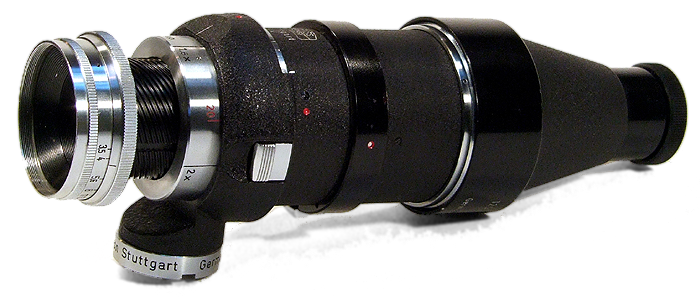
The special 50mm Tessar lens is mounted in the focus head, on a long stroke helical system. This head mounts on an external ramp type bayonet and has a distance scale ranging from just under 20 cm to infinity. Along with the distance scale is an exposure correction scale. The distance setting allows to go beyond infinity for a simple matter of minimum space and storage. No lubrication is necessary on the helical part. The aperture ring ranges from 1/3.5 to 1/22.
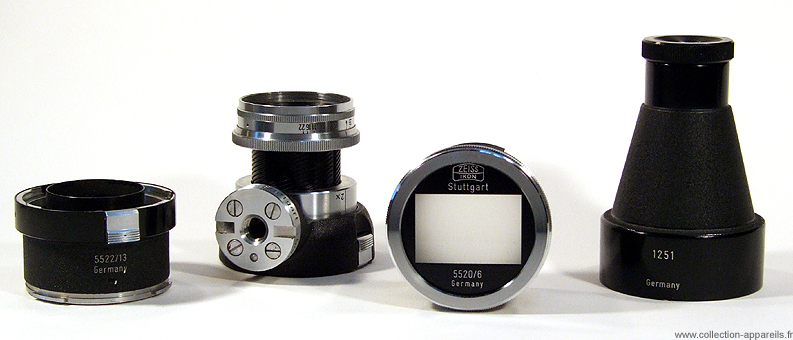
The magnifying glass is straight, but another version of Contaprox with an angled magnifying glass (with an internal mirror) was also available.
The use of the Contaprox could be done directly, by focusing on the ground glass with the magnifying glass, then replacing the ground glass / magnifying glass assembly with the camera when it was time to take the shot. And this, with or without the use of extension tubes or bellows.
Otherwise, the Contaprox could be used with a “revolver” turret, still with or without extension tubes.
Focusing with a Contaprox mounted on a "revolver" turret with a x1 extension tube :
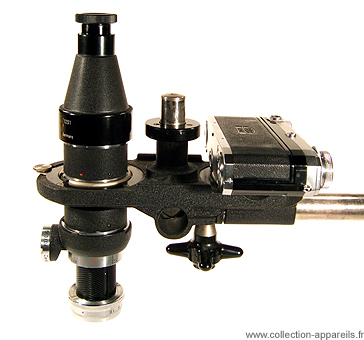
The shooting :
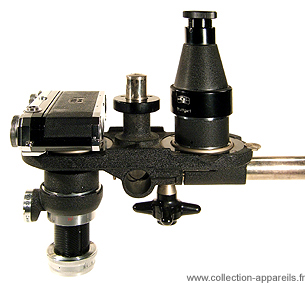
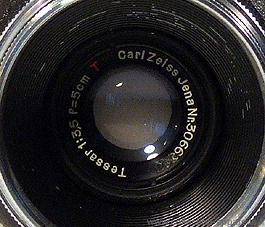
The Tessar macro shown here is an engraved Carl Zeiss Jena lens therefore manufactured in East Germany, and marketed by Zeiss Stuttgart in a Contaprox system manufactured in Stuttgart. Later these same lenses will be engraved "Opton" therefore manufactured in Oberkochen, and even later Carl Zeiss, still manufactured in Oberkochen.
Another way to do this was to use the Panflex.
The Panflex
This accessory was also initially dedicated to macro photography and it would have been diverted for portrait with the use of a 117mm lens, of special construction considering the flange focal length featured by the Panflex. The Panflex consists of a reflex viewfinder system that fits between the Contax and the focusing head of the 50mm macro Tessar. The action on the cable release first raises the mirror and then, at the end of the stroke, triggers the camera shutter. Mounted on the Panflex, the infinity setting of the Tessar 50mm macro is no longer usable because a stop in the Panflex prevents excessive retraction of the optics so as not to interfere with the movement of the Panflex mirror and damage it. The Panflex is said to have only been manufactured in a thousand units.
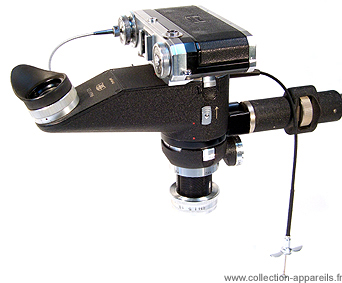
The basic documentation of the time to have a proper use of the Contax IIa: the user manual, the 1953 Otto Croÿ book Das Contax Buch and the lenses characteristics tables:
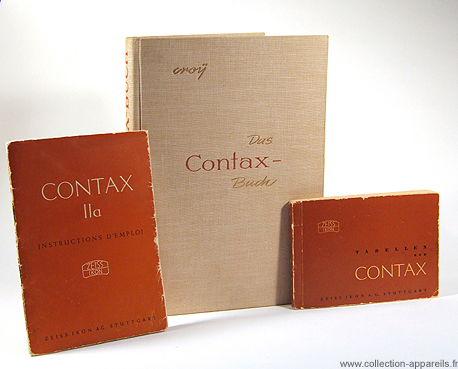
Interesting links or bibliography :
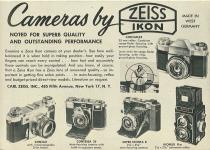 Photography Magazine de 1954 | 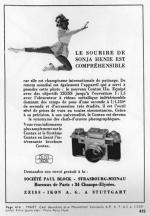 Photo Almanach Prisma de 1952 | 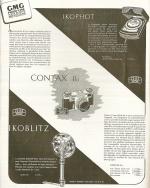 Photo Ciné Revue de 1951 |
Add a link or element of bibliography, a picture taken with this camera, a picture of box or an ads about this camera
Your photos taken with the same camera:
Cameras from Ebay France (Zeiss Ikon) (Uploaded each 3 hours)
 appareil photo argentique Praktiflex FX , avec objectif Carl Zeiss Jena 2/58 110,00 euros Finira le 20-05-2024 à 06:59:45 |









